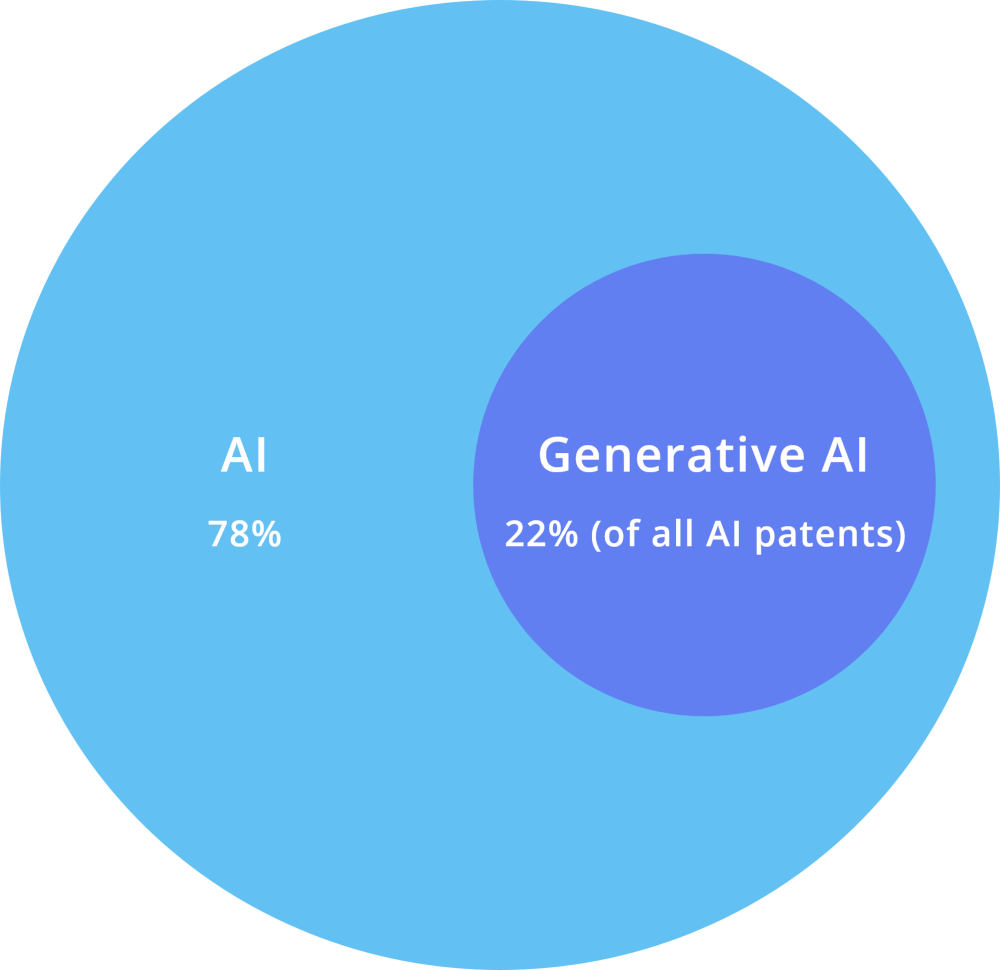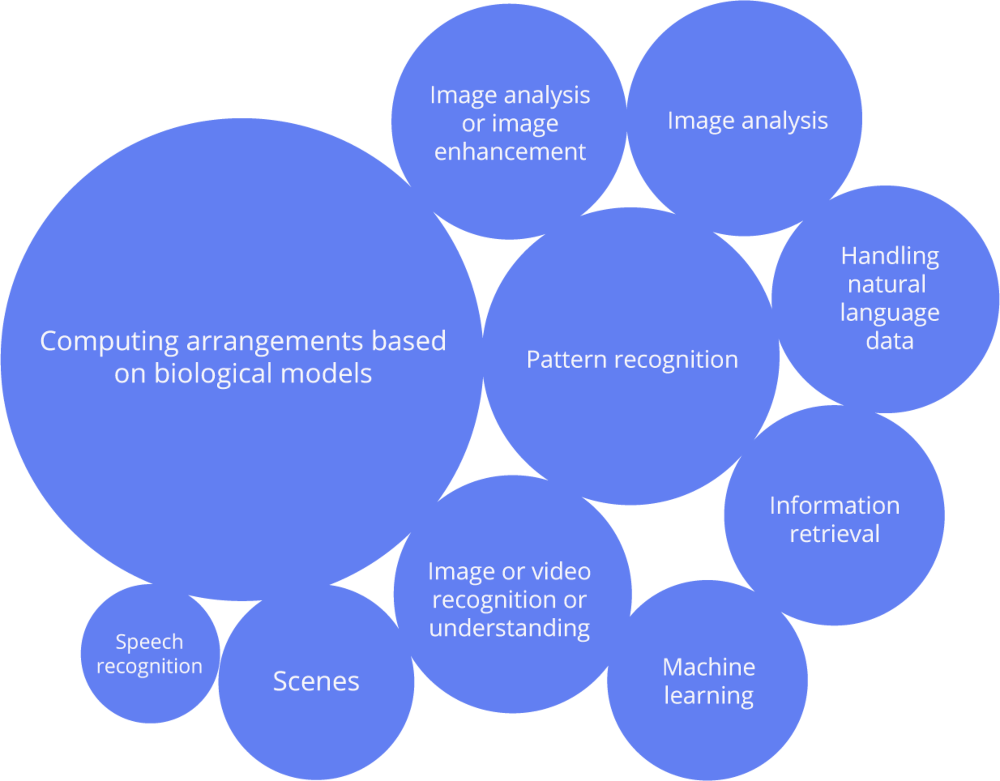IFI Insights: Opening the Patent Picture on Generative AI
2023 was a year-long bash for artificial intelligence. The guest of honor at the party? Generative AI, in the form of ChatGPT. While the world wonders whether this human-like technology can replace what people do, investors want to figure out how to throw money in front of this tech locomotive barreling down the tracks. Here at IFI CLAIMS, we want to know how the patents stack up and which companies have protected inventions in this promising frontier.

An AI Transformation
It has been a little over a year since OpenAI’s ChatGPT went viral, and the technology has shown itself to be nothing short of groundbreaking. The potential for generative AI (GenAI) to change our culture and how companies conduct business has inspired both awe and alarm. Wage earners wonder if their jobs will be filled by AI workers. Business leaders are looking for ways to integrate the technology to solve business problems while decreasing costs. And with GenAI’s ability to supercharge human intelligence, researchers are pondering the possibilities for leaps in scientific advancement for such diseases as cancer or dementia.
As with any new technology, there are problems. So-called “hallucination,” or the tendency to make stuff up, needs to be fixed. And, of course, there is always risk for bias, which will raise plenty of ethical questions. GenAI has to be trained on data, much of it proprietary to other organizations. In the past few weeks, the New York Times dropped a lawsuit against OpenAI and Microsoft for copyright infringement. So regulators have a lot to grapple with.
IFI CLAIMS, the most trusted patent data provider in the industry, has something important to add to the continuous discussion about ChatGPT and GenAI—an examination of inventions in the GenAI space, because patents are an important indicator in estimating the likely victors in any nascent technology. First, a note on this analysis: Patent professionals generally use established classification systems to refine searches within specific technologies. With newer technologies, those classifications are built out and honed over time. The patent coding system often trails state-of-the-art technologies; as a result, they are assigned more general classifications. IFI tailored a query that used technologies currently in play for GenAI. As time goes on, the classifications will enlarge.
Our findings—gathered without any help from ChatGPT—in this leading-edge space are enlightening. Highlights are below:
Next Generation AI
Because of its ability to transform almost every aspect of life, artificial intelligence (AI) has been one of the most important issues affecting our society. The field covers a range of technologies with applications for computer science, medicine, finance, agriculture, and manufacturing, among many others. The substance of AI boils down to this: the process of training computers on large data sets so that the machines can make predictions and solve problems in a way that mimics human reasoning. Machine learning, artificial neural networks (a.k.a. deep learning) and natural language processing are some of the technologies that underlie AI. The world is certainly heading in this direction, and companies have been hard at it in the race to claim patent space in the area; over the past five years, more than half a million AI-related patent applications have been filed in the U.S.
Within the overall realm of AI is the subset of GenAI, a type of artificial intelligence that not only is trained to recognize patterns, but also has been endowed with a human-like ability to generate its own content, be it text, pictures, or videos. We estimate that approximately 22% of the patents under the AI umbrella are linked to GenAI. Such technologies would be centered around generative adversarial networks (a type of machine learning), large language models, and neural network models called generative pre-trained transformers (the technology behind the acronym GPT, which is now synonymous with GenAI).

GenAI’s Progression and Principal Patenters
Advancement doesn’t always play out in smooth, upward rides (as in the crypto craze followed by the crypto winter followed by the current crypto renewal). But over the past few years, the trendline for GenAI patent applications demonstrates an emerging technology that is gaining momentum. Patent grants in the area have grown at a compound annual rate of 16% over the past five years, while applications, the best indicator for what hot technologies companies are currently chasing, has grown at a rate of 31%.
As far as companies trying to protect their GenAI innovations, IBM is the elephant dancing in this AI boom, with 1,591 applications, a third more than Google. IBM announced last year that it was taking a more selective approach to its patenting strategy, focusing on five main areas. AI is one of those innovation zones. Third-place Microsoft, incidentally, has invested more than $10 billion in OpenAI since 2019. While we’re on the subject of ties between Microsoft and OpenAI, Microsoft very briefly hired OpenAI’s CEO Sam Altman, the face of GenAI, this past November during the whole kerfuffle between Altman and the OpenAI board.
Why is this important to mention? Because the company behind ChatGPT, which set the world on fire and is practically a household name now, isn’t one of the top ten applicants in GenAI. It isn’t even in the top 25. In fact, IFI CLAIMS can find fewer than five patents. This is surprising for an organization that is knowledge-based. That said, there could be more filings that aren’t yet public. Or, OpenAI could be relying heavily on the practice of holding trade secrets in order to keep its proprietary technology and model under wraps. The company’s bedrock technologies would surely relate to large language models and transformer architectures using artificial neural networks—technologies that have been developed and used by plenty of other companies. For example, when we explicitly searched for generative pre-trained transformer technology, we found patents from IBM, Google, Microsoft, Salesforce and Adobe, among others. For example, a Salesforce application granted more than a year ago, US-11487999-B2, covered spatial-temporal reasoning through pretrained language models.
Growth of Generative AI Applications & Grants
Leading Applicants in Generative AI
The Patent Technology Spheres Laying the Foundation for GenAI
Though certainly novel, an invention isn’t a completely new, new thing. Any invention builds upon patents and technology architectures that have come before, and GenAI is no different on that score. To the unscientific among us, ChatGPT appeared as this unfamiliar, modernistic marvel. But many of the underlying technologies had already been created and improved upon over the years—until they started to converge in a way that fashioned a technology infrastructure that could create new subject matter on its own. Pattern recognition, handling natural language data, speech and image recognition are all component technological abilities for any sort of artificial intelligence, including (and especially) GenAI. But the patent class that GenAI is leaning most heavily on is a subclass called “computing arrangements based on biological models,” a technology that has been a fast grower over the years, according to IFI’s analysis.
Understanding the science of life, from the molecular level to an entire organism (and the systems that support it), requires a staggering amount of data and computational power. This sort of biological technology helps advance fields in medicine, ecology, microbiology, and virology. Being able to, say, create a virtual heart to predict the sequence of cardiovascular disease or to map an infectious disease like COVID-19 and then forecast the results of vaccination rates, are an enormous benefit to society. But one of the key technologies in this patent subclass is deep learning, particularly a type called convolutional neural networks. Such networks help machines see and interpret images, for instance, as humans do, which makes this patent class cornerstone to GenAI.

The Patent Generators
In addition to having the most patents in GenAI, IBM is covering four bases of content generation: images, speech, text, and video. Google and Samsung are doing the same, while others are focusing on particular competencies. Here is one example of a pending Google application that generates speech: EP-4268225-A1. And one from Adobe that generates images: US-20230230198-A1.
In content generation technologies, Nvidia’s patent specialization centers around images and video. A pending application filed last August, for example, covers techniques to detect and amplify the speaker in a video conference: US-20230394627-A1. Nvidia’s influence goes well beyond just its GenAI patents though. The company’s mighty GPUs and CUDA framework are powering the space. Demand for its tools rocketed in 2023, sending the stock price into the stratosphere, increasing by more than 230% for the year. In the company’s most recent quarterly results release, founder and CEO Jensen Huang said growth was in “full throttle.” The root of that precipitous increase? “The era of generative AI is taking off,” he said.
Generative AI Technology Areas by Company